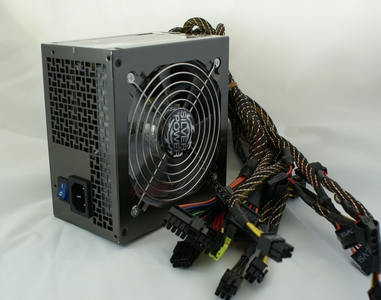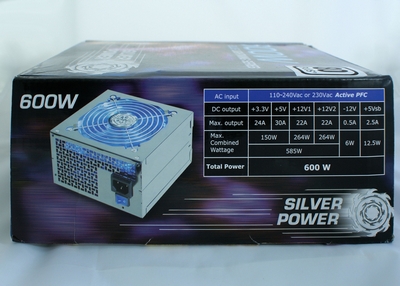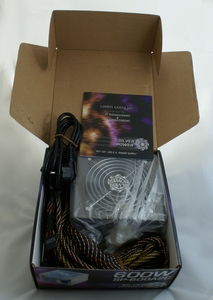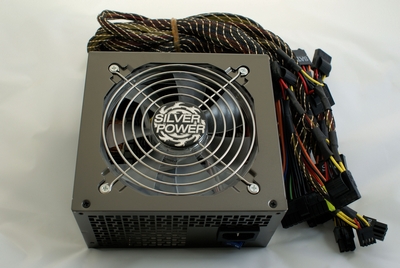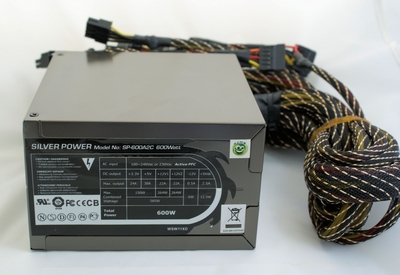Looking for a new power supply but don’t need a full kilowatt to drive up the energy bills? Read on as we have a look at the Silver Power SP-600A2C 600W power supply.
INTRODUCTION
In days gone by, power supplies used to be the most overlooked component in the computer. I remember my early days of PC building when it was all about finding the cheapest PSU you could get your hands on and looking for “just enough” when it came to wattage. No more, however, as the power supply market has exploded. Now we see everything from those same cheap power supplies to $500 models pushing over 1300 watts of power. Just the other day I pulled a co-worker’s computer apart. It’s about three years old or so and it’s running a 250W power supply. I didn’t even know those existed anymore! But I digress.
What we have here today is a pretty “middle of the road” entry from Tagan, in the form of the Silver Power 600W. Let’s face it. Most of us don’t need 1300 watts of power pulsing through our systems. Sure, it’s nice to have the bragging rights that come along with that package, but why spend all that extra money when you could spend it on something else, like software or even extra memory?
So let’s have a look at it, the Silver Power 600W, part of their Blue Lightning Series.
ABOUT MAXPOINT HANDELSGESELLSCHAFT MBH
Many people here in the US are not familiar yet with Silver Power. The reason is not because they are newcomers, but because Silver Power is the European division of MaxPoint, the parent company for several power supply brands including Tagan, who kindly provided us with this review sample. I’ll let them explain it:
MaxPoint is a leading and international operating producer and importer of innovative IT-peripherals with its headquarters in Ahrensburg near Hamburg (Germany). Established in 1993 the company repeatedly has attracted attention due to groundbreaking new product developments and awards. Further milestones in Maxpoint’s global activity are the foundations of branch offices as follows:
1998 Raidsonic Technology GmbH, Germany
2004 NanoPoint SARL, France
2004 NanoPoint Co. Ltd, United Kingdom
2004 NanoPoint Technology Inc., Taiwan
2006 Tagan Technology Co., USA
At present, the MaxPoint Group consists of eight divisions concentrating independently from each other on their particular clientele, but offering a well-adapted overall portfolio.
With the emphasis on Power Supplies MaxPoint sells the following four brands:
Tagan – Full range PS for gamers and enthusiasts
Seasonic – High-end PS, highly efficient, reliable and silent
Silverpower – Full range and nice priced series
Etasis – PSU for server application (redundant PS and IPC)
MaxPoint, therefore, always satisfies specific clientele thus offering a well-adapted overall portfolio in the PS market.
Further strong products: Cases and Keyboards
Aplus – High-end PC cases for gamers, stylish living persons and office
Rack Max – 19” IPC Cases
KeySonic – Keyboards and mice of high quality and outstanding design
Newcomer: Bags
Bagadillo – Notebook bags – for people with a sense of trends
MaxPoint Group has turned the single divisions into well-known suppliers, leading in their corresponding industries.
FEATURES AND SPECIFICATIONS
The Tagan Silver Power SP-600A2C is a pretty standard power supply. Not a lot of bells and whistles or features make it a must-have, at least on the surface. The numbers that are on the box are fairly standard, with the maximum output being slightly higher than the ThermalTake PurePower 600W that it’s being tested against. This is helpful when it comes to those moderately sized multi-GPU systems, along with the two PCIe connectors.
This unit is a little disappointing when it comes to video card connectors though. I was pretty surprised to see that both PCIe connectors are 6-pin only. With the number of 8-pin GPU’s on the market, it would’ve been nice to see at least a 6+2 PCIe connector.
This PSU is also 80 Plus certified, the newest certification standard for power supplies, meaning that it is certified to be greater than 80% efficient.
|
TAGAN Silver Power SP-600A2C FEATURES |
| Compatible with Intel ATX12V Ver 2.2 & 1.3 |
| 80 Plus Certified |
| 120mm fan with “Blue Lightning” |
| “Super Low Noise” |
| 2x PCIe 6-pin |
| 6x SATA connector |
| Active Power Factor Correction with a PF value of > 0.98 |
| Lower power consumption in standby mode |
| Automatic fan speed adjustment controlled by thermal sensor |
| Short-circuit, overvoltage, and undervoltage protection |
|
24 month warranty |
So what is 80 PLUS you ask? Here’s a quote from Tagan’s website:
80 PLUS is a innovative, electric utility-funded incentive program to integrate more energy-efficient power supplies into desktop computers and servers. Participating utilities and energy efficiency organization across North America have contributed over $5 million of incentives to help the computer industry transition to 80 PLUS certified power supplies. The 80 PLUS performance specification requires power supplies in computers and servers to be 80% or greater energy efficient at 20%, 50% and 100% of rated load with a true power factor of 0.9 or greater. This makes an 80 PLUS certified power supply substantially more efficient than typical power supplies and creates a unique market differentiation opportunity for power supply and computer manufacturers.
| TAGAN Silver Power SP-600A2C SPECIFICATIONS | ||||||
|
AC input |
100-240Vac or 230Vac Active PFC | |||||
|
DC output
|
+3.3V | +5V |
+12V1
|
+12V2 | -12V | +5Vsb |
| Max. output |
24A
|
30A |
22A
|
22A | 0.5A | 2.5A |
|
Max. |
150W |
264W
|
264W | 6W | 12.5W | |
| 585W | ||||||
|
Total Power
|
600 Watts | |||||
A CLOSER LOOK: PACKAGING
The packaging on the Silver Power is pretty straight forward. It’s a typical box with specifications listed on the side and a listing of features on the back. Because it is marketed in so many countries, the features are written in five different languages. Without further ado:
The last picture shown above is the only trouble I noted in regards to packaging. The power supply is not held in place by any kind of padding or insulation. It’s held in place by its own cabling. If someone were to drop the box on its top it would very likely result in a damaged power supply. Also, the included accessories are pictured above. They are limited to a power cord and an instruction manual. Often we will see adapters included for PCIe or other items, but here it is pretty sparse.
A CLOSER LOOK: POWER SUPPLY
As you can see in the above pictures, this is not a modular power supply. It’s not a big deal as modularity usually adds cost, but it’s always a nice touch when you do see it. One thing you can’t really get a feel for, however, is that the cables are not really all that long. They’d do fine in a mid-sized ATX case, but you would most likely run into some issues if you try to work it into a full tower or anything with a bottom-mounted power supply. In the case of the recently reviewed DD Tower 26, the cables would reach, but cable management was non-existent because I had to run cables directly because there was no slack.
TEST SETUP
For testing purposes, we will be looking at voltage output and the fluctuations, both at idle and load. We are looking for as little fluctuation as possible and as close to the desired voltage as possible. For the test rig, we will use my everyday test system, which is pretty standard nowadays. We are not looking to push this power supply to its breaking point. It’s just not informative, nor is it feasible. Synthetic testing is great, and it has its place, but it’s not what we do here at Bjorn3D.com. Here, we take a more “real-world” approach. We test each component in a system that, while cutting edge, is not out of the realm of possibility for the average enthusiast. Recently, I heard rumors of a 1300W power supply being demonstrated by running two full quad-core systems, with no hiccups at one of the recent technology conventions, though I have not been able to substantiate it. That kind of testing just isn’t feasible for us, nor is it for you, our readers. A much more measured approach is often appreciated, and our testing, in my opinion, is far more realistic.
| TAGAN SP-600A2C TEST SETUP | |
|
Case
|
Danger Den Tower 26 |
|
Motherboard
|
EVGA 780i Tri-SLI
|
|
CPU
|
Q6600 1.384v @ 3.2 GHz
|
|
Memory
|
Corsair XMS2 2x1024MB 5-5-5-15
|
|
GPU
|
EVGA 8800GT SC 714/1779/1032
|
|
HDD
|
2 X WD Caviar SE 160GB RAID 0
|
|
PSU
|
Silver Power SP-600A2C
ThermalTake PurePower 600W
|
|
Cooling
|
Laing DDC 12V 18W pump
MC-TDX 775 CPU Block
Ione full coverage GPU block G92
Black Ice GTX480 radiator
|
|
Software
|
Prime95
Folding@Home GPU2 client
Nvidia PhysX Particle Fluid Demo
|
For measuring results, we will be using a Kill A Watt meter to determine the total load, in watts, exerted on my wallet. We will use a Craftsman digital multimeter to measure the individual voltages and their fluctuations at the connectors. For idle testing, all non-essential processes were stopped and the system was allowed to idle for ten minutes. For load testing, Prime95 was run with the “small FFT’s” test to maximize CPU usage in addition to using the Folding@Home GPU2 client to load the GPU, along with the “Nvidia PhysX Particle Fluid Demo” to further tax the system.
If you don’t know what folding@home is, you can read about it in our forums here. It’s for a good cause and we at Bjorn3D.com would welcome your participation. Just remember that we are team #41608. And by the way, if you stop on in at our forums, why not go ahead and join? It’s simple. It’s easy, it’s free, and we give away prizes monthly (shameless plug).
The current ATX 2.2 specifications allow for the following variation in voltage outputs:
- 3.3 Volt Rail: 3.135 – 3.465V
- 5 Volt Rail: 4.75V – 5,25V
- 12 Volt Rail: 11.4V – 12.6V
TEST RESULTS
| Power Output Results(V) Measured With Craftsman Multimeter |
|||||
| Power Rail |
ThermalTake PurePower 600W
|
Silver Power 600A2C
|
|||
|
Idle
|
Load | Idle | Load | ||
|
3.3v
|
3.33
|
3.31 |
3.29
|
3.27 | |
|
5v
|
5.07
|
5.11 |
4.99
|
5.00 | |
|
12v1
|
12.05
|
12.07 |
12.33
|
12.18 |
|
| 12v2 | 12.08 | 12.09 | 12.35 | 12.23 | |
|
5vSB
|
5.04 |
5.08 |
4.98 | 4.97 | |
|
Wattage Used
|
224W
|
370W |
213W
|
357W | |
I was fairly impressed with the numbers that this power supply exhibited. I was a little concerned at first at the disparity between the idle and load 12v rail numbers. Doing the math, however, it comes out to about 1%, which isn’t bad. The numbers on the 12v rails also seemed high, until I did a little more math and figured out that even at 12.35v, it’s just a hair under the 3% tolerance that we like to keep our voltages within, which is actually quite good. What I really liked, however, was the difference at idle and load on the other rails. They are more or less rock solid.
You can also see the results of the higher efficiency of this unit compared to the ThermalTake through the lower overall power consumption driving the same components, which implies higher efficiency. Twelve or thirteen watts may not seem like much, but over time it equates to savings. Thirteen watts is the same amount of power used in a standard CFL bulb after all.
It should also be noted that there was no ripple on the rails at idle or at full load. The readings on the multimeter were rock steady.
| Power Factor Percentage Measured with a Kill-A-Watt |
|||
|
Power Supply
|
Idle
|
Load
|
|
|
Silver Power SP-600A2C
|
0.98
|
0.99
|
|
The power factor here is incredible and at 99% it is not easily beat. Power factor is the ratio of true power or watts to apparent power or volt amps. They are identical only when current and voltage are in phase, then the power factor is 1.0. True power or watts can be measured with a wattmeter. If the true power is 1870 watts and the volt amp reading is 2200, then the power factor is 0.85 or 85 percent. True power divided by apparent power. The power factor is expressed in decimal or percentage. Thus, power factors of 0.8 are the same as 80 percent. With low power factor loads, the current flowing through electrical system components is higher than necessary to do the required work. This results in excess heating, which can damage or shorten the life of equipment. A low power factor can also cause low-voltage conditions, resulting in dimming of lights and sluggish motor operation.
CONCLUSION
As most of us know, the power supply has taken more of a center stage than in previous years. This is due to a few things, but has more to do with the increased power consumption of the individual components, and those components’ increased cost. It’s no longer sensible to skimp on a power supply when your video card and motherboard alone cost upwards of $700. That being said, it is in our nature to save money wherever possible. It is a rare find when you come across a power supply that can deliver clean, stable power at an affordable price. Unfortunately I think that Silver Power has achieved one without the other. The SP-600A2C is a power supply that, while fairly solid, seems overpriced for the features that you get. While this power supply is not yet available in the US, it has been available in Europe for some time now. The price point seems a little steep for a 600W power supply at just under $100 USD. This may be due more to the cost of computer components in Europe, which seem to be slightly higher than here in the US, and I don’t think that I would pay that high a price for it. I did like the power supply overall but cost is still a big factor for many, many users.
As for features, this unit is pretty vanilla. Power is stable, and just within the 3% range that we recommend here at Bjorn3D.com. Cables are sleeved nicely, but short. Power across most of the rails is pretty rock solid, but on the 12v rails it has a decent amount of voltage drop although it is still well within tolerances. The bright spot, so to speak, is the LED fan. It is extremely quiet, and adjusts automatically based on temperatures inside the unit. During usage I did not notice any excessive noise from it at all. It does add a fairly bright blue glow to your case, so if you’re using other colors, be prepared for a bit of modifying.
The biggest drawback that I’ve seen with this power supply is the fact that it only has two 6-pin PCIe connectors. Granted, this power supply has been around since late 2007 according to some other review dates that I’ve seen. That, however, doesn’t change the fact that it’s priced to be at the top of its class, but doesn’t provide the features to support that price. With all the GPU’s out there that are requiring 8-pin PCIe connectors or two 6-pin connectors each, I see this as being a big problem for many users. One other thing I would liked to have seen is modular cabling. It has become more and more commonplace in recent months, and it really adds a lot of value when you’re a user that considers cable management to be a top priority.
Pros:
+ Stable power
+ 80 Plus efficiency compliance
+ Sleeved cables
+ 99% power factor
+ Quiet performance
+ Runs cool
Cons:
– High price for a fairly vanilla power supply
– Cables may be too short in a full tower case
– No modular cabling
In the end, this is a good power supply but I leave it up to you to decide if you want to spend the money on it or not.
The SP-600A2C has earned a final score of 7.5 out of 10.0.
 Bjorn3D.com Bjorn3d.com – Satisfying Your Daily Tech Cravings Since 1996
Bjorn3D.com Bjorn3d.com – Satisfying Your Daily Tech Cravings Since 1996
